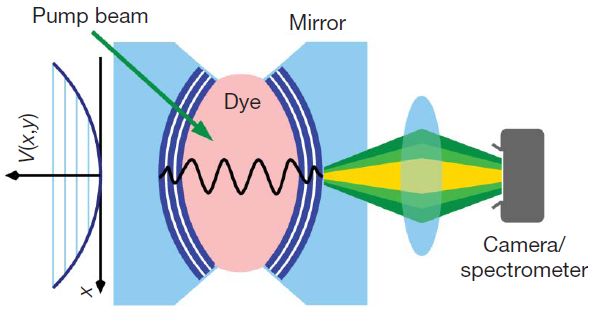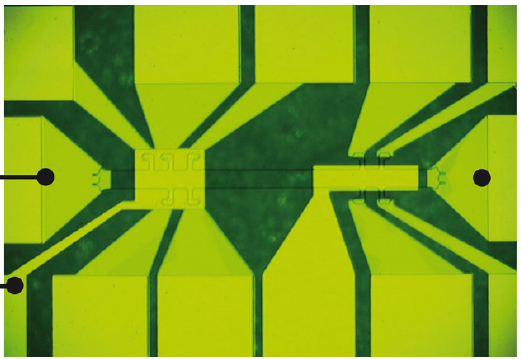
Photo by Philippe Teuwen via wikimedia.
This week’s issue of the magazine Science has no less than three papers on a single topic, namely new ways of computing using the quantum mechanical property of spin. Taken together, these provide a brief glimpse into the different ways researchers have progressed in incorporating spin into electronic devices.
The fundamental element of a computer chip is the transistor. The transistor is where the bits are switched from 0 to 1 and vice versa. Transistors are made from semiconductors such as silicon and operate by moving electrical charges between two contacts. But electrical charges are not the only possibility to operate a computer. Another one is to use spin.
What is spin and why do we care?
Spin is a quantity that is related to the rotation of fundamental particles around their own axis, similar to a spinning top. The concept of spin is deeply rooted in quantum mechanics, pioneered by people such as Wolgang Pauli and Niels Bohr. Of course, the analogy of such a fundamental property to a spinning top does not work fully. If you want to learn more about the intriguing world of spin, take a look at Dave Goldberg’s blog post.
But how does spin have any relevance in computing? Well, if the particle with spin also has an electrical charge, as the electron does, this also creates a magnetic field, similar to that of a tiny compass. This magnetic field can be used to store information just like an electric charge. Whether the compass points upwards or downwards then corresponds to the 0 and 1 of a bit.
[…]
Continue reading...
Light is special. In our everyday experience it behaves like a wave, which gets reflected, refracted and shows interference with other light of the same wavelength. At the same time, light also consists of particles, so-called photons. This duality is quite fundamental: the Hanbury Brown and Twiss experiment for example only works because of the particle-like properties of light.

The experimental setup. A laser beam injects photons into a cavity filled with light, and a camera observes the photons coming out of the cavity. Reprinted by permission from Macmillan Publishers Ltd. Nature 468, 545-548 (2010).
This amazing and perhaps confusing duality, where light in one experiment appears to be a wave and in others it behaves like particles, is now laid bare in a paper published in Nature. There, Jan Klaers, Martin Weitz and colleagues from the University of Bonn in Germany take one of the classical properties of light waves and turn it upside down — by demonstrating a related effect that only works when considering the particle qualities of light!
The classical effect they use is that light waves can all oscillate synchronously. This is exactly what happens in a laser, and is typical behaviour for a class of particles to which photons belong to, the bosons. Bosons love to be all in the same state.
A similar synchronous behaviour can also occur for other bosons, including certain atoms, which then all assume the same quantum state. This state is called a Bose-Einstein condensate, after Satyendra Nath Bose (after whom bosons are named) and Albert Einstein, who described it first in 1924. It is a Bose-Einstein condensate of light that Weitz and colleagues have now demonstrated. […]
Continue reading...

Photo of the electronic device used to measure the high electron mobility in ZnO. Reprinted by permission from Macmillan Publishers Ltd. Nature Materials (2010). doi:10.1038/nmat2874
Even if you don’t know much about this compound, everybody is familiar with zinc oxide (ZnO). It is a white powder used as the UV-light absorbing component in many sun lotions (and the part of the sun lotion that leaves those white marks on clothes), as an antibacterial agent in some baby powders, in rubbers where it promotes vulcanisation, or as white pigment in colours, and for many other products.
And even now ZnO remains one of the most widely studied oxygen-containing oxide compounds — and this is not going to change anytime soon. In a paper that is now published in my journal Nature Materials, Atsushi Tsukazaki, Masashi Kawasaki and colleagues from Tohoku University in Japan accomplished growing ZnO to such high purity that its electrons can move at extremely high speeds. The material is so clean that it shows quantum effects that are only known from a few very pure compounds. Darrell Schlom from Cornell University in the USA, who works on the growth of oxides, is quite enthusiastic: “Oxides have the unfortunate stigma of being associated with dirt, bricks, and toilet bowls. I love this rags to riches story because it shows that oxides can be clean, so clean that with ZnO they have broken into the most exclusive and elite club that was reserved for just half a dozen of the world’s cleanest materials. This is the greatest achievement of the year for oxides!”
Indeed, the ZnO thin films that Tsukazaki and colleagues grew are so clean that electrons in them move so fast that the researchers were able to observe the so-called Fractional Quantum Hall Effect (FQHE), a first for any oxide compound. The FQHE is a sign that electrons are in quantum states that can be used in quantum computing, and by showing the FQHE, ZnO has established itself as a candidate material for such schemes.
[…]
Continue reading...





December 17, 2010
3 Comments